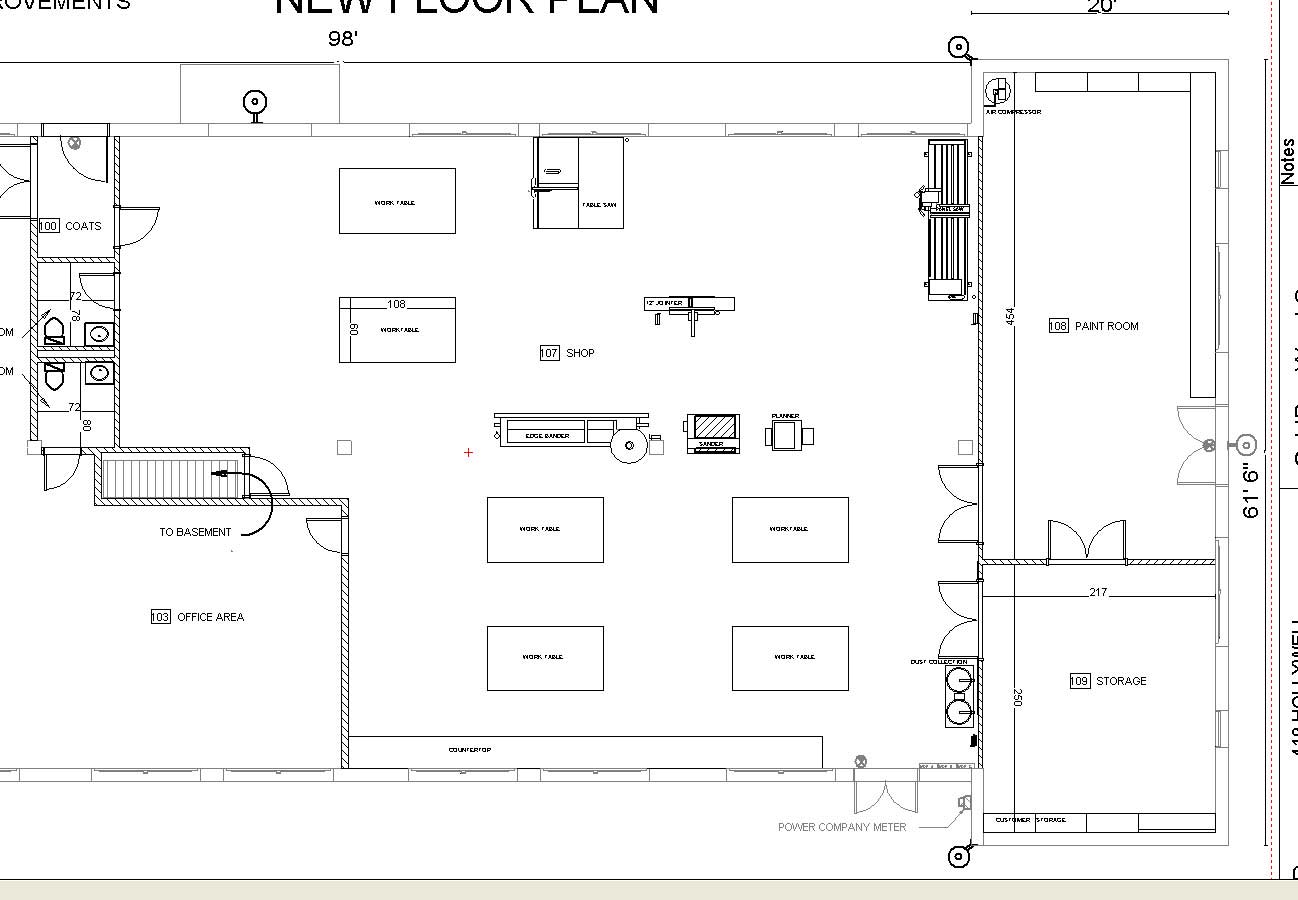Question
I am in the process of converting a building ( 120' X 60' ) into my cabinet shop. I would like to get advice from people who have had to deal with air Purification for paint rooms. I am also looking for information on a Fire Suppression system for paint rooms, and just general advice for a new location that is still in the late concept stage. Building permits and inspections are going to require some modifications. Here is an image below.

Forum Responses
(Finishing Forum)
From contributor L:
The only thing I have for air purification in my system is a 5 micron water filter and a 0.01 micron oil filter. On top of that I would like to add a refrigerated dryer but the $1,200 can be well spent on other stuff seeing as I don't have any problems with my finishes using the air I have.
With the room that you have, if you put the fan on the 20' wide wall, you will need to have 16,000 CFM (8' ceiling), 18,000 CFM (9') or 20,000 CFM (10') fan - unless you have a smaller booth within the room that has an area that is smaller to keep your 100 feet per minute of airflow. For air inflow I use 8-20" x 25" (28 sq ft) filters, they are designed for spray booths and have a sticky substance on the inflow side to capture any particles that try to sneak by. I would make all of the doors into the room close and seal when the fan goes on.
For fire suppression all I have is a few fire extinguishers by each exit door. It would be nice to have a ceiling mounted system similar to the ones they have at gas stations. A halon system would be best as it wouldn't ruin your product if the fire hasn't already. I would incorporate a drying room within the spray room. This way you can have a smaller area to place your freshly sprayed parts. This would keep the air flow over them to a minimum to prevent solvent pop in the finish and you can heat this smaller area easier and to a higher temperature that you could keep the larger area at.
You will need to have active ventilation in this room to keep the solvent vapors down and to keep air in movement. If you have winter temperatures you need to think about a heat make up system to heat the incoming air your fan will draw out.
Also, make sure to move your vacuum system closer to your dust producing machines. I think your tablesaw is to close to the wall and your planer needs to be turned 90º and also you don't show where your wood and plywood storage will be.
You should set up your machines in a production manner. You don't want to have to be walking back and forth to the different machines during your processes. Table saw, jointer and planer should all be right together. In my shop, I have made sure that I have 10' in front and behind the planer and wide belt sander. I also put the planer and the wide belt sander side by side, which they share the same trunk on the dust collection that is regulated with blast gates. Definitely get your dust collection closer to your machines. The closer they are the better the suction.
My point is to involve your fire marshal in the planning of your paint room and not just the final inspection. Maybe he is the type to allow for you doing it yourself or maybe he will want you to go and install a prefab booth and such. Contributor L and Contributor D have written some valuable contributions here that to me are priceless.
Second, filtration falls into three categories. You have vapor elimination (that is the solvent once it has evaporated) then you have particle removal - that can be by either dead end filtration (like your furnace filter that you replace from time to time) or precipitation filters (these range from electrostatic precipitators in coal plants to spray dryer cyclone types used to collect powders as they dry after chemical processes.
For vapor elimination you have to have high air throughput (which can suck if you live in a cold climate because you heat air then expel it) or carbon based charcoal absorbents (like you find in the cartridges on respirators). What kind of climate do you live in? How cold can the room be?
As far as particle elimination – pre-filtration will help a lot. Find a big mesh that will take a lot of it out, then a fine (HEPA) filter that will eliminate the fine particles. The big mesh will have smaller and smaller pore sizes as if fills with particles but will save life time on the fine particle filters in your HEPA filters. You can clean then a few times outside with compressed air to save money.